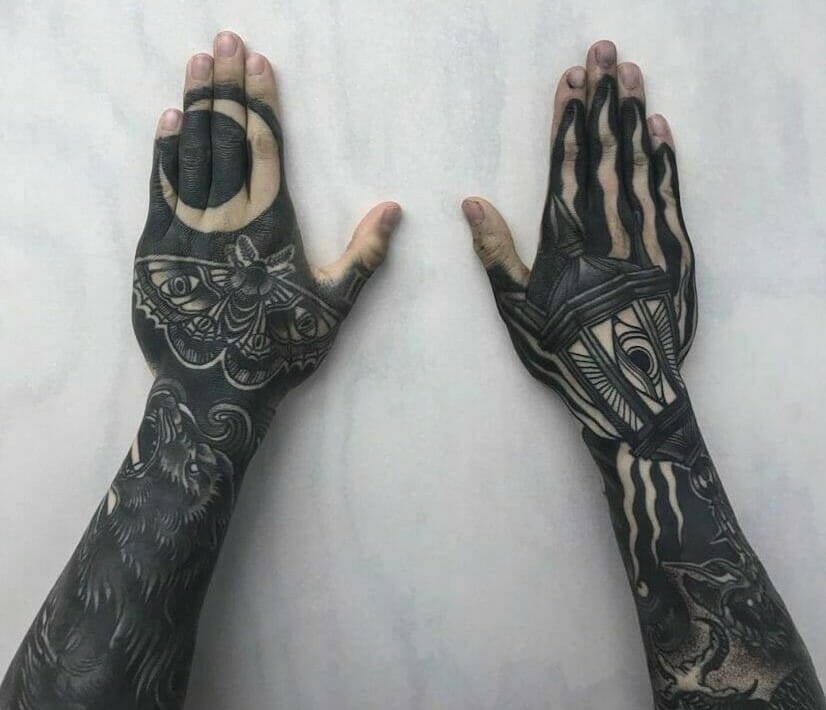
Alright, so you’re thinking about going full blackout on that old hand tattoo, huh?
I get it.
Maybe it’s faded, maybe it’s a reminder of a bad decision, or maybe your style just changed.
But is a blackout tattoo the right move?
Let’s dive in.
Hand Tattoo Regret? Blackout Might Be the Answer
Hand tattoos are cool.
Until they’re not.
I’ve seen everything from tribal bands that scream "2003" to names of exes that haunt people daily.
So, can you cover it with solid black?
Generally, yes.
But there’s way more to it than just slapping some ink on.
What to Consider Before Getting a Blackout Tattoo
Think of a blackout tattoo as a serious commitment.
It’s not like lasering off a tiny butterfly.
Here’s the real deal:
- Pain Level: Hands are notoriously painful.
- We’re talking bone-on-skin, nerve-rich territory.
- Imagine someone repeatedly scratching a sunburn with a dull needle.
- Artist Selection: Not all artists are created equal.
- You need someone experienced in blackout work.
- Check their portfolio for solid, even coverage.
- Don’t cheap out! This is your skin we’re talking about.
- Healing Time: Hand tattoos take longer to heal.
- You’ll need to be extra careful with aftercare.
- Constant hand washing and movement can make it tricky.
- Scarring: Covering an existing tattoo increases the risk of scarring.
- Especially if the old tattoo was heavily saturated.
- A good artist will minimize this, but it’s a possibility.
- Social Impact: A completely blacked-out hand is a statement.
- Are you prepared for the reactions and questions?
- Will it affect your job or personal life?
I had a friend, let’s call him Mark, who blacked out his entire forearm.
He said the pain was intense, but the biggest shock was the constant comments from strangers.
Be ready for that.
How Blackout Tattoos Actually Work
Blackout tattoos involve saturating the skin with a lot of black ink.
The goal is to completely obscure the old tattoo underneath.
It sounds simple, but it requires skill and patience.
Here’s what to expect:
- Multiple Sessions: You’ll likely need several sessions to achieve full coverage.
- The artist will layer the ink to ensure a solid, even finish.
- Ink Quality: High-quality black ink is crucial.
- Cheap ink can fade or heal unevenly.
- Ask your artist about the ink they use.
- Aftercare is Key: Proper aftercare is essential for healing and preventing infection.
- Keep the area clean and moisturized.
- Avoid direct sunlight and excessive sweating.
- Listen to your artist’s instructions!
Can I Get a Blackout Tattoo: Exploring Other Options
Before committing to a full blackout, consider these alternatives:
- Laser Tattoo Removal: This can lighten the old tattoo, making it easier to cover with something else.
- It’s a process, but it can open up more design possibilities.
- Cover-Up Tattoo: A skilled artist can often create a new design that incorporates or completely hides the old one.
- This requires careful planning and design work.
- Partial Blackout: Maybe you don’t need to go completely black.
- A strategic blackout can highlight certain areas and create a unique look.
I once helped a client design a cover-up that turned a poorly-done heart into a stunning mandala.
Sometimes, a little creativity goes a long way.
FAQ: Blackout Tattoos on Hands
- Is it safe to get a blackout tattoo?
- Yes, if done by a reputable artist using sterile equipment.
- However, there are always risks associated with tattooing, such as infection and allergic reactions.
- How much does a blackout tattoo cost?
- It varies depending on the size, location, and artist’s rates.
- Expect to pay more for a skilled artist and multiple sessions.
- Will the old tattoo completely disappear?
- Ideally, yes.
- However, some faint outlines or scarring may still be visible.
- Can I get a blackout tattoo if I have sensitive skin?
- Talk to your artist and dermatologist.
- They can assess your skin and recommend the best course of action.
So, you’re still wondering, "Can I get a blackout tattoo to cover my old hand tattoo?"
Absolutely, it’s possible.
Just make sure you weigh the pros and cons, choose a talented artist, and be prepared for the commitment.







